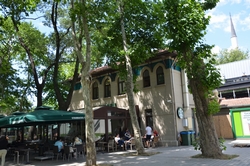 |
| The Bilgi University Starbucks. |
After a week and a half in
Istanbul, I have started to fall into a rhythm. I wake up every day, get
dressed, and make my way downstairs, where I meet my classmates at the Bilgi
University shuttle. Once on campus, we all split apart and visit our favorite
breakfast venues on campus before rushing off to class. After class, it is time
for lunch before taking the shuttle back to the dorms, where I take my
afternoon siesta. No matter what, I will never give up my Roman siestas. After
taking a nap, I usually start working on my readings for the next class before
heading out to the local restaurant for dinner.
This rhythm may not seem that strange to you, but I have been very surprised by how similar Istanbul is to home and how different it is from my expectations. Aside from the mosques that can be seen just about everywhere, Istanbul does not seem that different from Europe. This is especially true when one takes a walk along Istaklal, a central shopping street I found myself walking on this afternoon. As a group of friends and I made our way to visit Mango, a clothing shop that caters primarily to women and fortunately for me, contains numerous benches for men to wait in, I was surprised by all of the foreign stores. Diesel, Quicksilver, North Face, Krispy Kreme, Starbucks, and McDonalds were all present, as well as hundreds of other brands that everyone back in the states would recognize. And these stores were not just limited to Istiklal Street, but can be found littered throughout Istanbul.
This rhythm may not seem that strange to you, but I have been very surprised by how similar Istanbul is to home and how different it is from my expectations. Aside from the mosques that can be seen just about everywhere, Istanbul does not seem that different from Europe. This is especially true when one takes a walk along Istaklal, a central shopping street I found myself walking on this afternoon. As a group of friends and I made our way to visit Mango, a clothing shop that caters primarily to women and fortunately for me, contains numerous benches for men to wait in, I was surprised by all of the foreign stores. Diesel, Quicksilver, North Face, Krispy Kreme, Starbucks, and McDonalds were all present, as well as hundreds of other brands that everyone back in the states would recognize. And these stores were not just limited to Istiklal Street, but can be found littered throughout Istanbul.
 |
| The Bosporus, one of the many sights I have come to love. |


